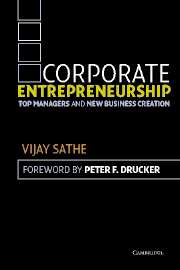Book contents
- Frontmatter
- Contents
- List of figures
- List of tables
- Foreword
- Preface
- List of abbreviations
- 1 Introduction
- 2 Why a consistent emphasis and approach for new business creation is beneficial but difficult to achieve
- I The business environment
- II The management culture
- III The corporate executives
- IV The division general manager
- V The division and its top management team
- VI Putting it all together
- Notes
- Bibliography
- Index
VI - Putting it all together
Published online by Cambridge University Press: 22 September 2009
- Frontmatter
- Contents
- List of figures
- List of tables
- Foreword
- Preface
- List of abbreviations
- 1 Introduction
- 2 Why a consistent emphasis and approach for new business creation is beneficial but difficult to achieve
- I The business environment
- II The management culture
- III The corporate executives
- IV The division general manager
- V The division and its top management team
- VI Putting it all together
- Notes
- Bibliography
- Index
Summary
The first five parts of the book examine each of the major influences on new business creation one by one. They are (1) the business environment, (2) the management culture, (3) the corporate executives, (4) the division general manager, and (5) the division and its top management team. This last part of the book considers their combined effect.
In Chapter 19, the focus is on understanding how the five major influences interact with each other to drive new business creation. This is illustrated for AMP Sigcom when Mike Walker was DGM. How the interactions changed to maintain and then reduce the thrust on new business creation under his successor, Clay Smith, is also described.
Chapter 20 highlights ten critical issues that cut across the five major influences driving new business creation. It also offers recommendations for top managers on how to manage these issues for better results.
- Type
- Chapter
- Information
- Corporate EntrepreneurshipTop Managers and New Business Creation, pp. 281 - 282Publisher: Cambridge University PressPrint publication year: 2003

